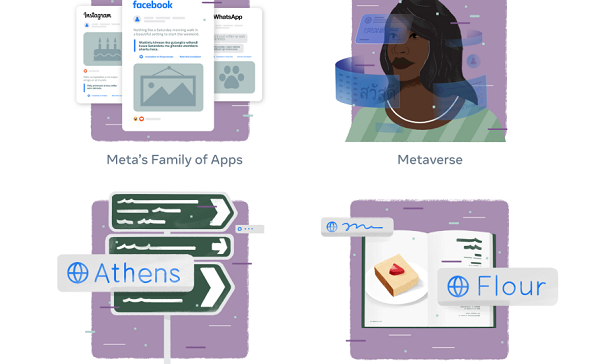SOCIAL
Meta Outlines Advances in Language Translation, a Crucial Consideration in Furthering Metaverse Connection

Meta’s looking to advance its language translation tools with the launch of a new ‘No Language Left Behind’ AI model, which can translate 200 different languages, while it’s also open sourcing its translation data to further improve its systems, and democratize technological access.
That video is about 3 minutes too long, but the gist is that Meta is looking to advance its translation models to facilitate greater access, not just in the social media platforms of today, but more importantly, within the coming metaverse space.
As explained by Meta:
“Language is our lifeline to the world. But because high-quality translation tools don’t exist for hundreds of languages, billions of people today can’t access digital content or participate fully in conversations and communities online in their preferred or native languages. This is particularly an issue for hundreds of millions of people who speak the many languages of Africa and Asia.”
To improve this, Meta has been developing systems that are able to learn language translations from smaller datasets, while it’s also working with native speakers, where possible, to refine its systems.
Which has led to the development of its new translation model
“We’ve built a single AI model called NLLB-200, which translates 200 different languages with results far more accurate than what previous technology could accomplish. When comparing the quality of translations to previous AI research, NLLB-200 scored an average of 44% higher. For some African and Indian-based languages, NLLB-200’s translations were more than 70% more accurate.”
That will expand accessibility to more regions, while also ensuring that lesser used languages live on into the future, another important consideration.
But Meta’s systems alone won’t be able to facilitate full detection and translation of some languages. Which is why Meta is also open sourcing its data to invite more native speakers and experts into the development process.
“We’re also awarding up to $200,000 of grants for impactful uses of NLLB-200 to researchers and nonprofit organizations with initiatives focused on sustainability, food security, gender-based violence, education or other areas in support of the UN Sustainable Development Goals. Nonprofits interested in using NLLB-200 to translate two or more African languages, as well as researchers working in linguistics, machine translation and language technology, are invited to apply.”
In combination, these initiatives will help Meta evolve its translation tools, which, eventually, will enable users in the metaverse space to more easily converse and engage, in real-time, through language translation tools.
Google, too, is advancing its efforts on this front, with its translation tools now able to transcribe foreign language speech as it’s happening, providing more ways to interact in the moment.
The hope is that this will eventually facilitate more global connection and opportunity, by removing barriers from connection. But then again, that was the great hope of the internet, and social media as well – that, in providing a means to connect, we would facilitate more understanding and community, by enabling more people to join in the global conversation, and add more perspectives to enrich our understanding.
That’s not quite how things have played out, but there is a unique value to enhanced language translation, especially in regions where many languages are spoken, while it may also, eventually, facilitate Star Trek-like universal translator type tools within metaverse spaces that could open up whole new realms of connection and opportunity, in totally new ways.
Which is why this is an important project, and while it may be difficult to fully envisage as yet, it is good to see Meta looking to establish translation tools at the foundational level of the metaverse shift.
It could end up being a critical development – you can read more about Meta’s evolving translation process here.
SOCIAL
Snapchat Explores New Messaging Retention Feature: A Game-Changer or Risky Move?

In a recent announcement, Snapchat revealed a groundbreaking update that challenges its traditional design ethos. The platform is experimenting with an option that allows users to defy the 24-hour auto-delete rule, a feature synonymous with Snapchat’s ephemeral messaging model.
The proposed change aims to introduce a “Never delete” option in messaging retention settings, aligning Snapchat more closely with conventional messaging apps. While this move may blur Snapchat’s distinctive selling point, Snap appears convinced of its necessity.
According to Snap, the decision stems from user feedback and a commitment to innovation based on user needs. The company aims to provide greater flexibility and control over conversations, catering to the preferences of its community.
Currently undergoing trials in select markets, the new feature empowers users to adjust retention settings on a conversation-by-conversation basis. Flexibility remains paramount, with participants able to modify settings within chats and receive in-chat notifications to ensure transparency.
Snapchat underscores that the default auto-delete feature will persist, reinforcing its design philosophy centered on ephemerality. However, with the app gaining traction as a primary messaging platform, the option offers users a means to preserve longer chat histories.
The update marks a pivotal moment for Snapchat, renowned for its disappearing message premise, especially popular among younger demographics. Retaining this focus has been pivotal to Snapchat’s identity, but the shift suggests a broader strategy aimed at diversifying its user base.
This strategy may appeal particularly to older demographics, potentially extending Snapchat’s relevance as users age. By emulating features of conventional messaging platforms, Snapchat seeks to enhance its appeal and broaden its reach.
Yet, the introduction of message retention poses questions about Snapchat’s uniqueness. While addressing user demands, the risk of diluting Snapchat’s distinctiveness looms large.
As Snapchat ventures into uncharted territory, the outcome of this experiment remains uncertain. Will message retention propel Snapchat to new heights, or will it compromise the platform’s uniqueness?
Only time will tell.
SOCIAL
Catering to specific audience boosts your business, says accountant turned coach

While it is tempting to try to appeal to a broad audience, the founder of alcohol-free coaching service Just the Tonic, Sandra Parker, believes the best thing you can do for your business is focus on your niche. Here’s how she did just that.
When running a business, reaching out to as many clients as possible can be tempting. But it also risks making your marketing “too generic,” warns Sandra Parker, the founder of Just The Tonic Coaching.
“From the very start of my business, I knew exactly who I could help and who I couldn’t,” Parker told My Biggest Lessons.
Parker struggled with alcohol dependence as a young professional. Today, her business targets high-achieving individuals who face challenges similar to those she had early in her career.
“I understand their frustrations, I understand their fears, and I understand their coping mechanisms and the stories they’re telling themselves,” Parker said. “Because of that, I’m able to market very effectively, to speak in a language that they understand, and am able to reach them.”Â
“I believe that it’s really important that you know exactly who your customer or your client is, and you target them, and you resist the temptation to make your marketing too generic to try and reach everyone,” she explained.
“If you speak specifically to your target clients, you will reach them, and I believe that’s the way that you’re going to be more successful.
Watch the video for more of Sandra Parker’s biggest lessons.
SOCIAL
Instagram Tests Live-Stream Games to Enhance Engagement

Instagram’s testing out some new options to help spice up your live-streams in the app, with some live broadcasters now able to select a game that they can play with viewers in-stream.
As you can see in these example screens, posted by Ahmed Ghanem, some creators now have the option to play either “This or That”, a question and answer prompt that you can share with your viewers, or “Trivia”, to generate more engagement within your IG live-streams.
That could be a simple way to spark more conversation and interaction, which could then lead into further engagement opportunities from your live audience.
Meta’s been exploring more ways to make live-streaming a bigger consideration for IG creators, with a view to live-streams potentially catching on with more users.
That includes the gradual expansion of its “Stars” live-stream donation program, giving more creators in more regions a means to accept donations from live-stream viewers, while back in December, Instagram also added some new options to make it easier to go live using third-party tools via desktop PCs.
Live streaming has been a major shift in China, where shopping live-streams, in particular, have led to massive opportunities for streaming platforms. They haven’t caught on in the same way in Western regions, but as TikTok and YouTube look to push live-stream adoption, there is still a chance that they will become a much bigger element in future.
Which is why IG is also trying to stay in touch, and add more ways for its creators to engage via streams. Live-stream games is another element within this, which could make this a better community-building, and potentially sales-driving option.
We’ve asked Instagram for more information on this test, and we’ll update this post if/when we hear back.
-

 PPC6 days ago
PPC6 days agoHow 6 SEO Experts Are Navigating Google Update Chaos
-

 SEARCHENGINES6 days ago
SEARCHENGINES6 days agoBing Search Testing Removing Cache Link From Search Results
-

 MARKETING6 days ago
MARKETING6 days ago60 Remote Work Stats to Know in 2024
-

 WORDPRESS5 days ago
WORDPRESS5 days ago10 WordPress Influencers to Follow in 2024 – WordPress.com News
-

 SEARCHENGINES7 days ago
SEARCHENGINES7 days agoOngoing Google March Core Update, Googlebot To Crawl Less, Pay For Google Search AI & More
-

 MARKETING5 days ago
MARKETING5 days agoFeeling Stuck: What to Do When You Don’t Know What to Do
-

 SEO6 days ago
SEO6 days agoGoogle Explains How It Chooses Canonical Webpages
-

 SEARCHENGINES4 days ago
SEARCHENGINES4 days agoMore Google March 2024 Core Update Ranking Volatility














You must be logged in to post a comment Login